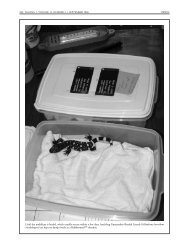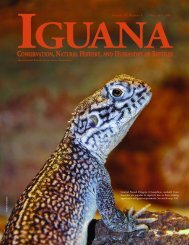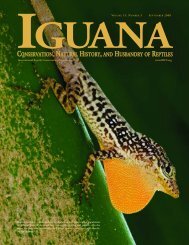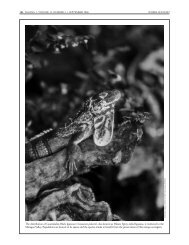Boa constrictor occidentalis - International Reptile Conservation ...
Boa constrictor occidentalis - International Reptile Conservation ...
Boa constrictor occidentalis - International Reptile Conservation ...
You also want an ePaper? Increase the reach of your titles
YUMPU automatically turns print PDFs into web optimized ePapers that Google loves.
WALLER ET AL.<br />
found a high degree of gene flow among studied populations,<br />
which they attributed to the high dispersal capability<br />
of males. However, a subsequently detected decrease in gene<br />
flow (Cardozo et al. 2007) could be the result of a progressive<br />
increase in habitat isolation. Strong differences in important<br />
life history traits (e.g., size, body condition, and reproductive<br />
output) in relation to habitat complexity have also been<br />
observed, and the long-term viability of boa populations at<br />
these locations is a matter of concern and the subject of ongoing<br />
research (e.g., Cardozo and Chiaraviglio 2008, 2011).<br />
According to our study, the clearing and replacement of<br />
forests and shrublands by crops and land for livestock rearing<br />
is responsible for a 29% decrease in the historical range of B.<br />
c. <strong>occidentalis</strong> in Argentina. Its current potential occupation<br />
area covers 30.2 million ha, some 12 million ha less than its<br />
historical potential (Table 1). Twenty percent of the identified<br />
habitat contraction is the result of changes in land use<br />
that occurred during the past decade. In absolute terms, the<br />
largest habitat loss took place in the provinces of Santiago del<br />
Estero, Salta, Chaco, and Córdoba, in which over 9 million<br />
ha of forests and shrublands were cleared. However, in relative<br />
terms, the most affected provinces were Tucumán and<br />
Santa Fe, since both have lost over 70% of the original habitat<br />
of this subspecies. The process, however, basically followed a<br />
centripetal pattern, which enhances the likelihood that large<br />
fragments of habitat will persist (Table 2). These provide for a<br />
continuous landscape in 90% of the remaining territory in the<br />
form of a large column of suitable habitat from the northern<br />
limit of the snake’s distribution in the province of Formosa,<br />
to its southernmost limit in the province of San Luis — with<br />
the notable exception of the provinces of Tucumán and Santa<br />
Table 1. Original habitat size and extent of habitat loss for <strong>Boa</strong> <strong>constrictor</strong> <strong>occidentalis</strong><br />
in Argentina.<br />
Original Current Habitat Habitat<br />
Province Habitat (ha) Habitat (ha) Loss (ha) Loss (%)<br />
Santiago del Estero 11,885,047 7,604,468 4,280,579 35.4<br />
Salta 6,921,872 5,045,602 1,876,270 15.5<br />
Chaco 6,206,342 4,419,698 1,786,644 14.8<br />
Formosa 3,956,459 3,651,826 304,633 2.5<br />
La Rioja 3,987,672 3,607,618 380,054 3.1<br />
Córdoba 3,229,838 1,945,404 1,284,434 10.6<br />
San Luis 2,284,646 1,923,426 361,220 3.0<br />
Catamarca 1,369,510 981,754 387,757 3.2<br />
Tucumán 1,039,506 287,853 751,653 6.2<br />
Santa Fe 693,781 174,375 519,407 4.3<br />
Jujuy 404,975 265,637 139,337 1.2<br />
San Juan 318,897 309,369 9,528 0.1<br />
Mendoza Occasional Occasional — —<br />
Extent of occurrence 42,298,545 30,217,030 12,081,516 28.6<br />
7<br />
IRCF REPTILES & AMPHIBIANS • 19(1):1–10 • MARCH 2012<br />
Table 2. Degree of fragmentation of the habitat of <strong>Boa</strong> <strong>constrictor</strong> <strong>occidentalis</strong><br />
in Argentina.<br />
Habitat Patch Number Total Area of Average Size<br />
Size (Ha) of Patches Patches (ha) of Patches (ha)<br />
>1,000,000 3 28,205,639 9,401,880<br />
100,000–999,999 1 102,819 102,819<br />
10,000–99,999 25 544,540 21,782<br />
1,000–9,999 281 691,254 2,460<br />
100–999 1,950 550,416 282<br />
>5–100 11,169 235,703 21<br />
Total 13,429 30,330,371 —<br />
Fe, where the isolation of populations now appears to be irreversible<br />
(Fig. 5).<br />
Suitable habitat for the Argentina <strong>Boa</strong> Constrictor in the<br />
18 national and provincial protected areas identified within<br />
its range covers barely 1.7% of its distribution area (716,824<br />
ha), with the aggravating factor that most of these areas<br />
have little to no effective protection. However, the recent<br />
enactment of a National Law for the Protection of Native<br />
Forest (Law 26.331) has promoted the development of Land<br />
Management Plans (LMP) in most provinces of the species’<br />
range. These LMPs establish the areas that should be preserved<br />
with their original forest cover and those that may be<br />
converted for agricultural use. In a scenario of full compliance<br />
with the LMPs prepared by nine of 13 provinces through<br />
Fig. 5. <strong>Boa</strong> <strong>constrictor</strong> <strong>occidentalis</strong> habitat loss in Argentina (black areas).<br />
One-third of what is known as the Dry Chaco forests and shrublands has<br />
been converted to crops or to grasslands for livestock production.








